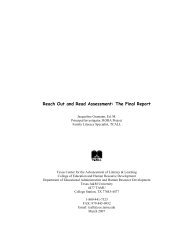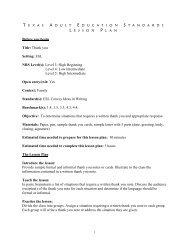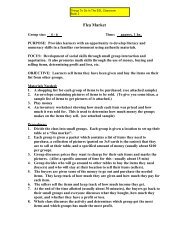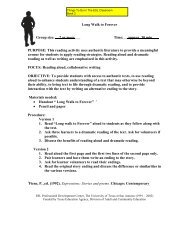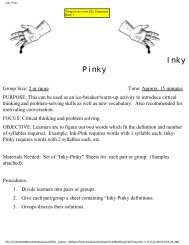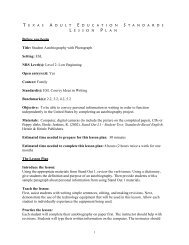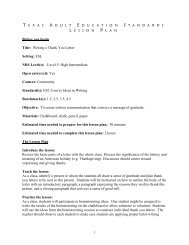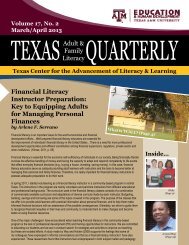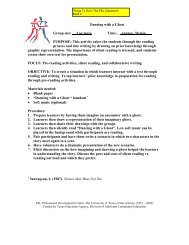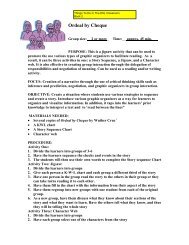You also want an ePaper? Increase the reach of your titles
YUMPU automatically turns print PDFs into web optimized ePapers that Google loves.
<strong>Puzzlers</strong><br />
Group Size: ___2 or more____<br />
Time: ___Approx. 15 min.__<br />
PURPOSE: This activity can be used as a warm-up for problem-solving and critical<br />
thinking. It engages learners in open communication where everyone can work<br />
together to solve the puzzles.<br />
FOCUS: Critical thinking, problem-solving and working together in a small group.<br />
OBJECTIVE: Learners are to read the puzzle and try to solve it.<br />
Materials Needed:<br />
Copies of puzzles for each group<br />
(The attached puzzles are examples that were taken from several different sources)<br />
Note: For adaptation for multi-level classrooms and to accommodate different<br />
learning styles, we have developed visual pieces for some of the puzzles that can be<br />
moved or manipulated to come to the solution.<br />
Procedures:<br />
1. Divide learners into pairs or groups<br />
2. Give each pair/group a set of puzzles<br />
3. Groups can discuss their solutions when everyone is finished.<br />
ESL Professional Development Center, The University of Texas at San Antonio (1991-2002)<br />
Funded by Texas Education Agency, Division of Adult and Community Education
Kids in a Circle Puzzle<br />
Nine schoolchildren form a circle. To choose a leader they decide to start<br />
from one of them, count up to 5 clockwise, ask the fifth player to leave, and<br />
so on. The last player left in the circle is the leader.<br />
Andrew does the counting. He wants to take advantage of this to become the<br />
leader. Let's call him and his friends by the letters A through I, clockwise.<br />
With which child should he start to count?<br />
Answer: If Andrew starts with A, the leader will be H. to be the<br />
leader himself, he must start two children more clockwise, that is with<br />
C.<br />
Berloquin, P. (1976). 100 numerical games. New York: Barnes and Noble.<br />
Cat’s Dream Puzzle<br />
Puss had taken a catnap. He dreamed that there were five mice sitting in a<br />
circle around him, four gray mice and one white mouse. In his dream Master<br />
says: “Go on, Puss, you can eat them up. But you can only eat each fifth<br />
mouse, going around in a clockwise direction. The last mouse you eat must<br />
be the white mouse.”<br />
Hint: Number the mice in a circle from 1-5. Pretend that Puss starts on the<br />
mouse at position 1. At what number must the white mouse be?<br />
Answer: “Suppose Puss starts at mouse number 1, marked with an X in the<br />
diagram. It will help if you draw one like this. Go around clockwise<br />
through positions 2, 3, 4, 5, which you cross out. Crossing out each<br />
fifth dot goes in this order: 1,2,4,5,3. So the white mouse must be at<br />
position 3, if Puss starts at position 1 and moves clockwise. Or he<br />
could go counter-clockwise from position 1; then the white mouse must be<br />
at position 4.”<br />
.<br />
Holt, M. (1976) 100 Numerical Games. New York: Barnes & Noble.
Cat’s Dream Puzzle - Manipulative pieces. Cut pieces apart<br />
Holt, M. (1976) 100 Numerical Games. New York: Barnes & Noble.
Snail Puzzle<br />
A snail has undertaken to climb a pile of ten bricks. It can climb four bricks in an hour.<br />
But then, since the effort has been extremely tiring, it must sleep an hour, during which it<br />
slips down three bricks.<br />
How long will the snail take to reach the top of the pile?<br />
Answer: 13 hours<br />
“The snail climbs the pile with an average speed of one brick every two hours.<br />
But it does not need twenty hours to climb ten bricks.<br />
At the end of the twelfth hour, the snail wakes up, fresh and rested, at the top of<br />
the sixth brick. Then it can spend the 13 th hour climbing the last four bricks to the<br />
top.”<br />
Ladder Puzzle<br />
Timothy is on a ladder placed against a wall he is painting. He starts<br />
on the middle rung, goes up five rungs, down seven rungs, up four rungs,<br />
and up nine more rungs, to reach the top bar.<br />
How many rungs are there on the latter?<br />
Answer: 23 rungs.. “Say Timothy starts on rung 0. HE goes up to rung 5,<br />
down to rung (-2), up to rung 2 and again up to rung 11. There are 2x11+1=<br />
23 rungs.<br />
Berloquin, P. (1976). 100 Numerical Games. New York: Barnes & Noble.
Who Has it All? Puzzle<br />
In a certain town, of each 100 men 85 are married, 70 have a telephone,<br />
75 own a car, and 80 own their own house.<br />
Always on a base of 100 men, what is the least possible number who are<br />
married, have a telephone, own a car, and own their own house?<br />
Answer: On the base of 100 men:<br />
‣ 15 are not married<br />
‣ 30 do not have a telephone<br />
‣ 25 do not have a car<br />
‣ 20 do not own their own house<br />
It is possible that these 90 men are all different, which would leave only 10 men<br />
with wife, phone, car and house.<br />
Berloquin, P. (1976). 100 numerical games. New York: Barnes and Noble.




